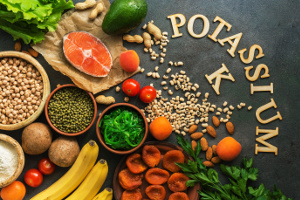Less sodium and more potassium can lower your risk of elevated blood pressure and stroke
 Potassium and sodium (which is found in regular table salt) work together in an elaborate and essential way in the body. Unfortunately, we get far too much concealed salt from industrially processed foods, and our intake of potassium from vegetables is often too low. This increases our risk of elevated blood pressure and stroke. Nonetheless, people on low-sodium diets have a lower risk of suffering a stroke and dying, according to a large Chinese study. The scientists assume that sodium may represent an inexpensive and simple way to improve public health. How important is it really to have the proper balance between sodium and potassium?
Potassium and sodium (which is found in regular table salt) work together in an elaborate and essential way in the body. Unfortunately, we get far too much concealed salt from industrially processed foods, and our intake of potassium from vegetables is often too low. This increases our risk of elevated blood pressure and stroke. Nonetheless, people on low-sodium diets have a lower risk of suffering a stroke and dying, according to a large Chinese study. The scientists assume that sodium may represent an inexpensive and simple way to improve public health. How important is it really to have the proper balance between sodium and potassium?
Around 20 percent of the Danish population has elevated blood pressure, in many cases without being aware of it. In the United States, 47 percent of the population has high blood pressure. It is a health problem that increases the risk of cardiovascular disease, kidney diseases, stroke, and premature death.
It is commonly known that overweight, smoking, alcohol, and physical inactivity increase the risk of hypertension, and hypertension is part of prediabetes – or metabolic syndrome – which is a lifestyle disease.
With regards to diet, high intake of sodium and low intake of potassium are associated with elevated blood pressure. The scientists behind the new Chinese study mention that many people with elevated blood pressure live in low or middle-income countries and are therefore in need of inexpensive ways to solve the health problem.
One way is to replace normal table salt with a type of salt that contains less sodium and more potassium.
|
Low-sodium diets help lower blood pressure and save lives
The large Chinese study has investigated the long-term effect of low-sodium table salt. The study was carried out on previous stroke sufferers and older people with a history of hypertension. Nearly 21,000 people from 600 towns in China participated. They primarily ate home-made food. Half of the participants got low-sodium salt that contained 75 percent sodium chloride and 25 percent potassium chloride. The other half – the control group – continued to use normal table salt that mainly contains sodium chloride.
Once a year, the scientists controlled the participants’ study compliance. Also, they took urine samples and measured blood pressure.
The results after nearly five years of follow-up showed that the participants consuming low-sodium salt had a 13 percent lower stroke rate and a 12 percent death rate compared with the participants in the control group that continued to eat regular table salt.
The scientists say that the study supports another Chinese study, according to which the use of low-sodium salt in China would result in 365,000 fewer cases of stroke and 461,000 fewer cases of premature death. They believe that a shift to this type of salt would represent a both practical and inexpensive solution in countries with low income rates and unhealthy diets, where people often tend to get far too much salt. In fact, this strategy would result in a number of health benefits and it would save lives in other parts of the world, as well. The new Chinese study is published in The New England Journal of Medicine.
|
Practical ways to get less salt and more potassium
The Chinese study points to the benefits of using low-sodium salt instead of regular table salt. There are products with far less sodium (sodium chloride) that contain potassium chloride, magnesium, and iodine.
Beware of the relatively large quantities of concealed salt in industrially processed foods. The best way to avoid this problem is to make as much of your food as possible from scratch so you can keep track of you salt intake.
For the record, normal table salt is enriched with iodine to prevent goiter. It also contains anticaking agents such as sodium aluminosilicate or sodium ferrocyanide. If you want to avoid these anticaking agents choose sea salt or Himalayan salt. Make sure to get plenty of iodine from other maritime sources.
It is generally advisable to eat many vegetables because they are rich in potassium, fiber, and other useful nutrients. Salt is used as a flavor enhancer in cooking but you can cut back on your salt intake by using plenty of herbs, instead.
|
References:
Bruce Neal et al. Effect of Salt Substitution on Cardiovascular Events and Death. The New England Journal of Medicine. September 16, 2021
James Kingsland. Switching to reduced-sodium salt may reduce stroke risk. MedicalNewToday. October 12, 2021
Houston M.C. The importance of potassium in managing hypertension. Curr. Hypertens. Rep. 2011. PubMed
Alt hvad du bør vide om Forhøjet blodtryk | Hjerteforeningen
Husholdningssalt - Wikipedia, den frie encyklopædi
Search for more information...
- Created on .








